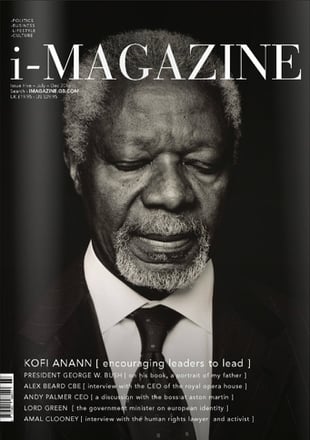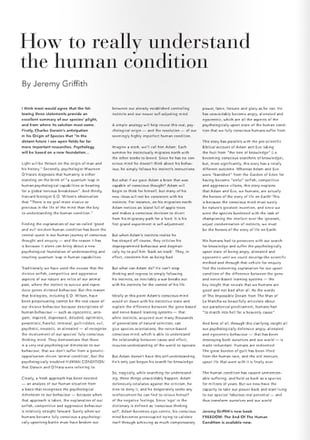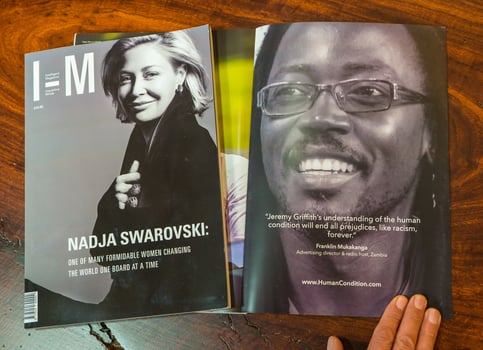i-MAGAZINE Guest Article By Jeremy Griffith
JULY-DECEMBER 2016 ISSUE
About i-MAGAZINE
i-MAGAZINE is a premium UK-based, internationally read biannual coffee table magazine that focuses on business, politics and lifestyle. Since launching in 2008, it has profiled such luminaries as Sir Richard Branson, Henry Kissinger, Kofi Annan, and Tony Abbott. Its editorial board includes members of the House of Lords and world-renowned business leaders. (www.i-m-magazine.com)

i-MAGAZINE PROFILE PIECE
To promote Griffith’s guest article in the July-December 2016 issue of i-MAGAZINE, the magazine first ran a detailed online profile piece about him and his work, which you can view by clicking on this image. The text of this profile piece is also included below the following reproduction of the actual magazine article.
Following the publication of Jeremy’s 2016 article, i-MAGAZINE devoted the inside back-cover of the July-December 2017 issue to a picture of Franklin Mukakanga, founder of the Zambian WTM Centre, across which are the words, “Jeremy Griffith’s understanding of the human condition will end all prejudices, like racism, forever” (this inside back cover picture is reproduced at the bottom of this webpage).

cover

article (reproduced below)
How to really understand the human condition
By Jeremy Griffith
I think most would agree that the following three statements provide an excellent summary of our species’ plight, and from where its solution must come. Firstly, Charles Darwin’s anticipation in his Origin of Species that “In the distant future I see open fields for far more important researches. Psychology will be based on a new foundation. Light will be thrown on the origin of man and his history.”
Secondly, psychologist Maureen O’Hara’s diagnosis that humanity is either standing on the brink of “a quantum leap in human psychological capabilities or heading for a global nervous breakdown”. And thirdly, Harvard biologist E.O. Wilson’s observation that “There is no grail more elusive or precious in the life of the mind than the key to understanding the human condition.”
Finding the explanation of our so-called ‘good and evil’ stricken human condition has been the central quest in our human journey of conscious thought and enquiry — and the reason it has is because it alone can bring about a new psychological foundation of understanding and resulting quantum leap in human capabilities.
Traditionally we have used the excuse that the divisive selfish, competitive and aggressive aspects of our nature are relics of our animal past, where the instinct to survive and reproduce genes dictated behaviour. But this reason that biologists, including E.O. Wilson, have been perpetuating cannot be the real cause of our divisive behaviour because descriptions of human behaviour — such as egocentric, arrogant, inspired, depressed, deluded, optimistic, pessimistic, hateful, immoral, guilt-ridden, evil, psychotic, neurotic, or alienated — all recognise the involvement of our species’ fully conscious thinking mind. They demonstrate that there is a very real psychological dimension to our behaviour; that we don’t suffer from a genetic-opportunism-driven ‘animal condition’, but the psychologically troubled HUMAN CONDITION that Darwin and O’Hara were referring to.
Clearly, a fresh approach has been needed — an analysis of our human situation from a basis that recognises the psychological dimension to our behaviour — because when that approach is taken, the explanation of our selfish, competitive and aggressive behaviour is relatively straight forward. Surely when we humans became fully conscious a psychologically upsetting battle must have broken out between our already established controlling instincts and our newer self-adjusting mind.
A simple analogy will help reveal this real, psychological origin — and the resolution — of our seemingly highly imperfect human condition.
Imagine a stork; we’ll call him Adam. Each summer he instinctually migrates north with the other storks to breed. Since he has no conscious mind he doesn’t think about his behaviour, he simply follows his instinct’s instructions.
But what if we gave Adam a brain that was capable of conscious thought? Adam will begin to think for himself, but many of his new ideas will not be consistent with his instincts. For instance, on his migration north Adam notices an island full of apple trees and makes a conscious decision to divert from his migratory path for a feed. It is his first grand experiment in self-adjustment.
But when Adam’s instincts realise he has strayed off course, they criticise his deprogrammed behaviour and dogmatically try to pull him ‘back on track’. They, in effect, condemn him as being bad.
But what can Adam do? He can’t stop thinking and regress to simply following his instincts, so inevitably a war breaks out with his instincts for the control of his life.
Ideally at this point Adam’s conscious mind would sit down with his instinctive state and explain the difference between the gene-based and nerve-based learning systems — that while instincts, acquired over many thousands of generations of natural selection, can give species orientations, the nerve-based conscious mind, which is able to understand the relationship between cause and effect, requires understanding of the world to operate.
But Adam doesn’t have this self-understanding. He’s only just begun his search for knowledge.
So, tragically, while searching for understanding, three things unavoidably happen: Adam defensively retaliates against the criticism, he tries to deny it, and he desperately seeks any reinforcement he can find to relieve himself of the negative feelings. Since ‘ego’ in the dictionary is defined as ‘conscious thinking self’, Adam becomes ego-centric; his conscious mind becomes preoccupied trying to validate itself through achieving as much compensatory power, fame, fortune and glory as he can. He has unavoidably become angry, alienated and egocentric, which are all the aspects of the psychologically upset state of the human condition that we fully conscious humans suffer from.
This story has parallels with the pre-scientific Biblical account of Adam and Eve taking the fruit from “the tree of knowledge” (i.e. becoming conscious searchers of knowledge), but, most significantly, this story has a totally different outcome. Whereas Adam and Eve were “banished” from the Garden of Eden for having become “sinful” selfish, competitive and aggressive villains, this story explains that Adam and Eve, we humans, are actually the heroes of the story of life on Earth! This is because the conscious mind must surely be nature’s greatest invention, and since we were the species burdened with the task of championing the intellect over the ignorant, unjust condemnation of instincts, we must be the heroes of the story of life on Earth.
We humans had to persevere with our search for knowledge and suffer the psychologically upset state of being angry, alienated and egocentric until we could develop the scientific method and through that vehicle for enquiry find the redeeming explanation for our upset condition of the difference between the gene and nerve-based learning systems — the key insight that reveals that we humans are good and not bad after all. As the words of The Impossible Dream from The Man of La Mancha so beautifully articulate about our paradoxical predicament, humans had “to march into hell for a heavenly cause”.
And best of all, through this clarifying insight all our psychologically defensive angry, alienated and egocentric behaviour — that has been destroying both ourselves and our world — is made redundant. Humans are redeemed. The great burden of guilt has been lifted from the human race, and the old insecure, upset life that went with it is finally over.
The human condition has caused unmentionable suffering, and held us back as a species for millions of years. But we now have the capacity to take our power back and start living to our species’ fabulous real potential — and thus transform ourselves and our world.
Given the perilous state of humanity, the presentation of this all-important explanation in my just released book, FREEDOM: The End Of The Human Condition, is not only available in bookstores, it is also freely available online at www.HumanCondition.com.
i-MAGAZINE’s Additional Online Piece On Jeremy Griffith
Jeremy Griffith
About Jeremy Griffith
The Australian biologist Jeremy Griffith has dedicated his life to bringing fully accountable, biological explanation to the dilemma of the human condition — how do we explain our species’ extraordinary capacity for what has been called ‘good’ and ‘evil’. While it’s undeniable that humans are capable of great love and empathy, we also have an unspeakable history of greed, hatred, rape, torture, murder and war; a propensity for deeds so shocking and overwhelming that the eternal question of ‘Why?’ has seemed depressingly inexplicable. Even in our everyday behaviour, why, when the ideals of life are to be cooperative, selfless and loving, are we so ruthlessly competitive and selfish that human life has become all but unbearable and our planet near destroyed? How could we humans possibly be considered good when all the evidence seems to unequivocally indicate that we are a deeply flawed, bad, even ‘evil’ species?
For most people, trying to think about this ultimate of questions of whether we humans are fundamentally good or not has been an unbearably self-confronting exercise. Indeed, the issue of the human condition has been so depressing for virtually all humans that only a rare few individuals have been sound and secure enough in self to go anywhere near what the human condition really is. Nurtured by a sheltered upbringing in the Australian bush (countryside), Jeremy is one of those rare few. His soundness and resulting extraordinary integrity and thus clarity of thought, coupled with his training in biology, has enabled him to successfully grapple with this most foreboding of all subjects of the human condition and produce the breakthrough, human-behaviour-demystifying-and-ameliorating explanation of it.
Born on 1st December 1945 and raised on a sheep station (ranch) in rural New South Wales, Australia, Jeremy was educated at Geelong Grammar School in Victoria, a school whose visionary approach to education has produced such notable alumni as Rupert Murdoch and HRH The Prince of Wales. He gained first class honours in biology in the state matriculation exams and in 1965 began a science degree at the University of New England in northern New South Wales. While there, Jeremy played representative rugby union football, making the 1966 trials for the national team, the Wallabies.
Deferring his studies in 1967, Jeremy hitchhiked to Tasmania (with his dog Loaf), determined to save the Thylacine — the Tasmanian Tiger — from extinction. Setting off with only a trail bike to carry Loaf, his pack and himself, he began by searching all the remaining wilderness areas for evidence of the Tiger’s survival. The search was to last for more than six years — the most thorough investigation ever into the plight of the Tasmanian Tiger — and by its conclusion he and his co-worker James Malley had attracted significant support and a Thylacine Research Centre had been established. Bob Brown, who went on to develop the Australian Conservation Movement and become a Federal Member of Parliament, donated his time and income for a year to support the Centre, which had two field units in operation and camera monitors that Jeremy invented in all likely wilderness areas. Sadly Jeremy concluded the ‘Tiger’ was extinct. His findings were internationally reported, with articles appearing in the American Museum of Natural History’s journal, Natural History, and Australian Geographic. His search also featured in an episode of the national television series A Big Country. In the official report of the search, Bob Brown said of Jeremy’s ‘Uncompromising drive’ to save the thylacine, that ‘the future ease with which anyone shall be able to assess the thylacine’s history and survival states in full and clear perspective will be due to him’. (To read the magazine articles and a more detailed account of the search, visit Jeremy Griffith’s Remarkable Search for the Tasmanian Tiger.)
In 1971 Jeremy completed his Bachelor of Science degree in zoology at the University of Sydney and the following year, in the same self-sufficient spirit with which he had undertaken the ‘Tiger’ search, he began manufacturing furniture to his own simple and natural designs. His idea was to make table tops from bark-to-bark slabs of timber, so Jeremy hitchhiked to the north coast of NSW where such slabs were available. He made his first table top by carting a slab in a wheelbarrow four kilometres from the sawmill to a joinery where it could be planed. The business grew and in late 1973 he was joined by one of his brothers.
By 1976 they had saved enough to buy a 54 hectare property, on which they built an immense pole-framed workshop. Their unique furniture received much critical acclaim, including an article titled ‘Craft as a Successful Livelihood’ published in Craft Australia (1978). The highly successful furniture manufacturing business employed some 45 people and was a major tourist attraction when, in 1991 Jeremy sold his share in the business. (Click here to read more about Griffith Tablecraft.)
© 2016 All right reserved. Merlin Publishing
i-MAGAZINE’s inside back-cover, July-December 2017 issue



